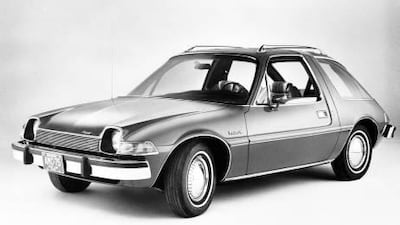Once in a while, a car is introduced that causes such a stir that the name its maker christened it with is soon replaced in common parlance by something far catchier. Some of these nicknames are crueler than others. The Austin Allegro, for instance, was so dogged by reliability problems that owners who spent longer lying beneath the axle than sitting behind the wheel dubbed it the "All-aggro". Such monickers are a marketing man's nightmare. Sumptuous photos of glamorous models draped over polished bonnets simply cannot compete with a catchphrase that catches on.
A "compact" car introduced at a similar time across the Atlantic was the AMC Pacer, a futuristic design intended to break the "big is better" mould that predominated in the USA. With its bulbous shape and huge expanses of glass, it was soon dubbed the "Flying Fishbowl". Clearly those using the term didn't relish the opportunity of hitting the highway in an automotive aquarium. These days, of course, the virtues of all-round visibility are well known and cars like the Fiat Multipa look more like an air traffic control tower than an automobile. But back then the car was still a shrine of steel.
It is said that fortune favours the brave, but in car design that is not necessarily the case. Often consumers take time to adjust to innovations and improvements, leaving the pioneer with plaudits but few purchases. The Pacer's designer, Richard Teague, dreamt of a compact car that was aerodynamic, economical and looked to the future rather than doffed its cap to the past. In short, he wanted to create an all-American European car.
But visionaries often have to make compromises on costs as the realities of business don't always match utopian ideals. The Pacer was intended to have front-wheel drive and a super-efficient rotary engine. Unfortunately these were concessions to cost, and conventional rear-wheel drive was adopted. However, some of Teague's innovations did make it into the production model. The most striking and talked-about design feature was the extended passenger door. This was 10cm longer than the driver's door to allow ease of access to the rear seats. This caused a problem on models exported to the UK where access for passengers was nigh on impossible except for those with Dukes of Hazzard dexterity.
This was the most conspicuous example of the brief to design from the inside out, rather than the outside in. This philosophy, now very much the norm, put passenger space and comfort as the prime objective. Most cars of the time were designed purely on looks and the interior only fitted later in whatever space was available.
The Pacer was considerably shorter than the average American car, but just as wide. This gave it an almost cartoon-like appearance that was not universally popular. Though some loved its futuristic lines, others thought it ugly and cumbersome. These days, the Pacer is one of the seminal icons of the Seventies, and highly collectible as a cult, or "nerd", classic, but it was offered in a market that had a preconceived idea of what a car looked like. Desperate to make the car profitable and boost sales, AMC modified the model to match customer expectations. Dispensing with thoughts of economy, it introduced a 5.0L V8 and, to counter complaints of a lack of load-space, it introduced a station wagon model. This more civilised, conventional design was widely lauded, indicating that the original concept was perhaps a little ahead of its time.
The Pacer makes for an interesting comparison between American and European motoring tastes. Stateside, the Pacer was compact, whereas in Europe it was enormous. In England a 3.8L engine would have powered a sports car and produced 300hp, but the Pacer engine of that size was only rated at 100hp, making the car slow and progress positively pedestrian. In Europe the Pacer was about as wide as a fire truck, not only unable to squeeze into a parking space but blocking entire roads in the process. Though in its low drag- co-efficient and hatchback format it pre-empted future European imports, it nonetheless emphasised the different paths that the industry had taken on either side of the Atlantic. In Europe, it could only ever have sold on its cult design and in France the marketing campaign compared its bulbous rear end with the silhouette of a lady's posterior!
In the end, the Pacer's futuristic design was let down by its dated technology. In compromising on cost, AMC had compromised on concept and produced neither the visionary car that people dreamt of, or the traditional car that it wanted.
Look back at the hits and misses in motoring history with Rearview Mirror.

